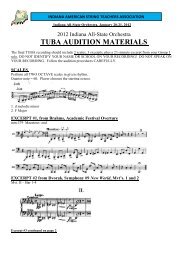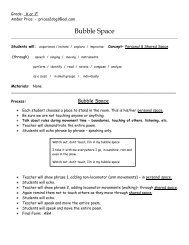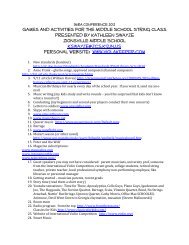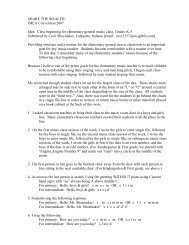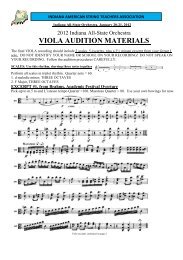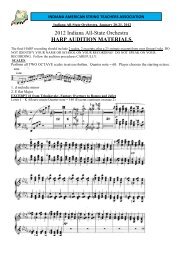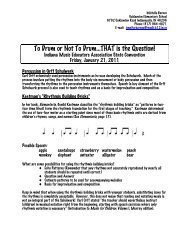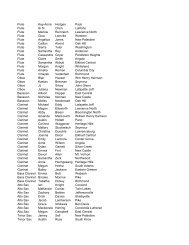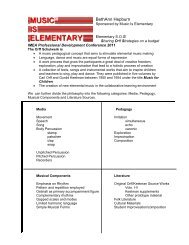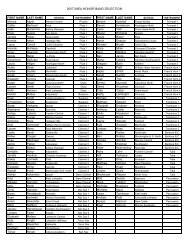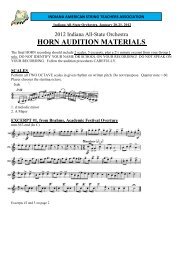no child left on his or her behind - Indiana Music Education ...
no child left on his or her behind - Indiana Music Education ...
no child left on his or her behind - Indiana Music Education ...
Create successful ePaper yourself
Turn your PDF publications into a flip-book with our unique Google optimized e-Paper software.
TOKYO DONTAKU<br />
(Japan)<br />
Tokyo D<strong>on</strong>taku is a B<strong>on</strong> dance, d<strong>on</strong>e at the annual celebrati<strong>on</strong> of the Feast of the Dead. It<br />
was introduced in N<strong>or</strong>th America in the early 1960s by Madelynne Greene, a respected folk<br />
dance teac<strong>her</strong>. She learned it in Ho<str<strong>on</strong>g>no</str<strong>on</strong>g>lulu in 1960 from the Japanese Hawaiian community.<br />
Although inexperienced dancers may find the co<strong>or</strong>dinati<strong>on</strong> of hands and feet challenging, even<br />
young elementary students may experience Japanese movements and music by learning<br />
just the hand gestures.<br />
<strong>Music</strong>, Video/DVD: The music can be found <strong>on</strong> Sanna's CD #1, Folk Dance <strong>Music</strong> f<strong>or</strong> Kids &<br />
Teac<strong>her</strong>s. The dance is taught both <strong>on</strong> Sanna’s Video/DVD #1, Fav<strong>or</strong>ite Folk Dances of Kids &<br />
Teac<strong>her</strong>s (red)—an adult folk dance group, and <strong>on</strong> Video/DVD#3, Living Ethnic Dances f<strong>or</strong> Kids<br />
& Teac<strong>her</strong>s (aqua)—<strong>on</strong> the flo<strong>or</strong> at a school family dance and to adults . Meter: 4/4<br />
F<strong>or</strong>mati<strong>on</strong>: Dancers face CCW individually.<br />
Rhythm= ta ta ti-ti ta (SSQQS)<br />
Styling: Steps are small as though wearing the narrow kimo<str<strong>on</strong>g>no</str<strong>on</strong>g> (m<strong>or</strong>e elab<strong>or</strong>ate, usually silk) <strong>or</strong><br />
yukata (less f<strong>or</strong>mal, usually cott<strong>on</strong>), and th<strong>on</strong>ged geta clogs. Keep knees toget<strong>her</strong> and slightly bent,<br />
feet a bit pige<strong>on</strong>-toed. Women's arms and hands are graceful and flowing; men's are str<strong>on</strong>g<br />
and flexible, all with fingers toget<strong>her</strong> and thumb under index finger.<br />
Dance Pattern<br />
Teach hands and feet separately, then combine; have students sit <strong>on</strong> flo<strong>or</strong> to learn the<br />
hand movements.<br />
PART I. Clap, clap, brush-up, clap. T<strong>his</strong> is a traditi<strong>on</strong>al start to many B<strong>on</strong> dances--<br />
perhaps drawing a picture of the sacred Mt. Fugi San.<br />
Hands: Clap hands in fr<strong>on</strong>t of chest (cts 1, 2), sweep hands down and out to sides with<br />
palms down (ct 3), sweep hands up in fr<strong>on</strong>t of chest (ct&), clap hands in fr<strong>on</strong>t of chest (4).<br />
Feet: R f<strong>or</strong>ward (ct 1), L f<strong>or</strong>ward (ct 2), R f<strong>or</strong>ward (ct 3)-L backward (et &), R close to L (cts 4&).<br />
May be modified to: R f<strong>or</strong>ward (1), L f<strong>or</strong>ward (2) R f<strong>or</strong>ward (3), L f<strong>or</strong>ward, (ct &), R f<strong>or</strong>ward (cts 4&).<br />
PART II. Paddle, paddle, shade your eyes.<br />
Hands: Move both palms bkwd <strong>on</strong> L side as though "paddling a boat" (ct 1); repeat <strong>on</strong> R side<br />
(ct 2), "shade eyes" with L palm at L ear and R arm extended in fr<strong>on</strong>t, palm f<strong>or</strong>ward (ct 3),<br />
reverse hands (et &), reverse again (ct 4&).<br />
Feet: L f<strong>or</strong>ward (et 1), R f<strong>or</strong>ward (et 2), L f<strong>or</strong>ward (et 3), R f<strong>or</strong>ward (et &), L f<strong>or</strong>ward (cts 4&).<br />
(c<strong>on</strong>tinued)



